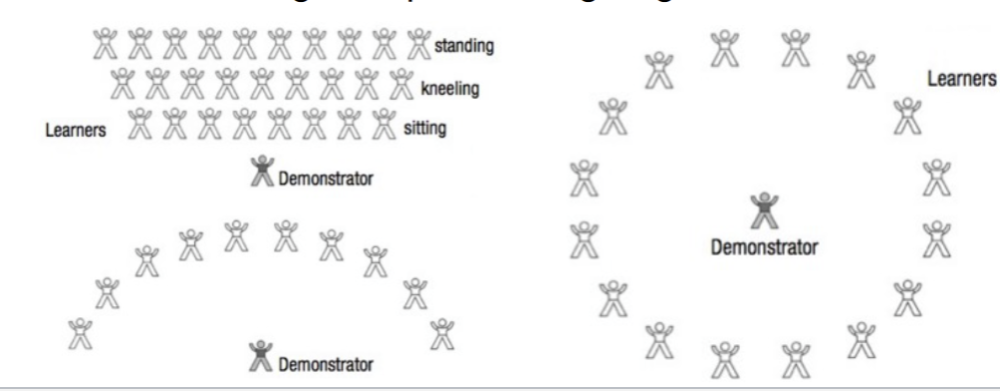Learner Preparation
• Capture undivided attention
- Remove all background distractions
Learner Preparation
• Be sure to be seen
and heard properly
- Position learners out of the elements
Learner Preparation
• Place all equipment used away
- to eliminate the temptation to use them
Learner Preparation
- Introduce skill in a manner that stimulates interest
Verbal Instructions
• Role of instructors
– Introduce
learner to new skill
• Communicate general idea or goal of
skill
• Make aware of major technical features
– Skill
refinement
• Develop skill level in order to perform
under
criterion conditions
- Introduce learner to a new skill
- Skill refinement
Verbal Instructions
• Role of
instructors
– Introduce learner to new skill
- Communicate general idea or goal of skill
- Make aware of major technical features
Verbal Instructions
• Role of
instructors
– Skill refinement
-
Develop skill level in order
- to perform under criterion conditions
Verbal Instructions
• Introducing the skill
- Draw learner’s attention to critical elements of the skill
Verbal Instructions
• Amount of information
- Keep explanations short and simple
- Supply only key elements needed to learn specific skill
Verbal Instructions
• Precise language
- Use developmentally appropriate language
-
Matches learner’s skill level
- Be clear and specific
Internal focus

Concentration on a specific body movement
External focus

Attention to effects of actions on environment
Constrained action hypothesis
-
External focus > internal focus
- External focus promotes automatic control
Verbal Instructions
• Awareness of
regulatory conditions
– Explicit learning:
instruction on rules
Verbal Instructions
• Awareness of
regulatory conditions
– Implicit learning
no verbal instructions on rules
Verbal Instructions
• Awareness of
regulatory conditions
Direction and exposure
- Early detection of task-relevant information
- Direct attention to information-rich areas
-
Expose to a variety of situations
- containing critical environmental regulatory cues
Verbal Instructions
- Awareness of regulatory conditions
- Learning styles
-
Previously learned skills
- Relating a new skill to an already learned skill
Verbal Instructions
• Verbal cues
- Word or phrase that focuses attention or prompts movement
-
Translates into self-talk,
- increase acquisition
- Must be concise: 1-2 words, no more than
- Must be accurate: clearly represents skill components
- Number should be limited
Verbal Instructions
• Check for understanding
Ask learner’s to restate important information
Observational Learning
• Mirror neurons
• Social cognitive theory
• Dynamic
interpretation of modeling
Observational Learning
• Mirror neurons
-
Fire if we perform an action
- while watching someone else do the same action
Observational Learning
• Social
cognitive theory
-
Processed info from model
- transformed into a cognitive representation of activity
Observational Learning
• Dynamic
interpretation of modeling
-
Pattern of coordination of the limbs
- relative to one another,
- scaled to individual properties
- Information obtained depends on age
WHAT Should be Demonstrated?
- Coordination vs. control
- Entire vs. spatial
- Real-time vs. slow motion
WHAT Should be Demonstrated? Coordination
-
new patterns of movements
using techniques
WHAT Should be Demonstrated? Control
- well-learned patterns using speed and force
WHAT Should be Demonstrated? Entire vs. spatial
Whole skill should be presented
WHAT Should be Demonstrated?
Real-time vs. slow motion
-
Real-time should be used mainly
- to develop a frame of reference for the skill
WHO Should Demonstrate?
- Expert vs. learning model
- Model-observer similarity
- Alternative mediums
WHO Should Demonstrate?
Expert vs. learning model
- Learning model has been shown to increase engagement in learning process
- Experts promote movement imitation
WHO Should Demonstrate?
Model-observer similarity
- Performance increases with similarity
WHO Should Demonstrate?
Alternative mediums
- Video
- Diagrams, (still photos)
- Auditory modeling (w/ skill tempo)
HOW Should the Demonstration be
Organized? (viewing)

-
Appropriate formations (semi-circle = best)
- See and hear demonstrations clearly
- Demonstrator not too close to learners
- Providing multiple viewing angles of the skill
HOW Should the Demonstration be
Organized
Explain demonstration procedure
Avoid showing the outcome
- Explain demonstration procedures
- Avoid showing the outcome
- Demonstrate both right and left limb dominance
HOW Should the Demonstration be
Organized
Explain demonstration procedure
- Highlight relevant features of movement
- Be specific in descriptions
HOW Should the Demonstration be
Organized
Avoid showing the outcome
-
Design demonstration
- = outcome is eliminated
- Learners focus on the basics
WHEN Should Demonstrations Occur?
- Introduction of a new skill
-
Interspersed throughout practice
- More often @early learning process
-
More experienced learners
- need fewer demonstrations
-
Allowing learners to control the number of
demonstrations
- provides autonomy
Learning
• Discovery learning
• Guided discovery
• Manual guidance
- Discovery learning
- Guided discovery
- Manual guidance
Learning
• Discovery learning
- “Constraints-led approach
- using a constructed environment
- Learner attempts to solve the movement problem
Learning
Guided discovery
-
Sequence of questions
- only a single correct response
Learning
Manual guidance
-
Practitioner or device moves the learner
through the
goal movement -
Keep Used sparingly
- better with self-discovery